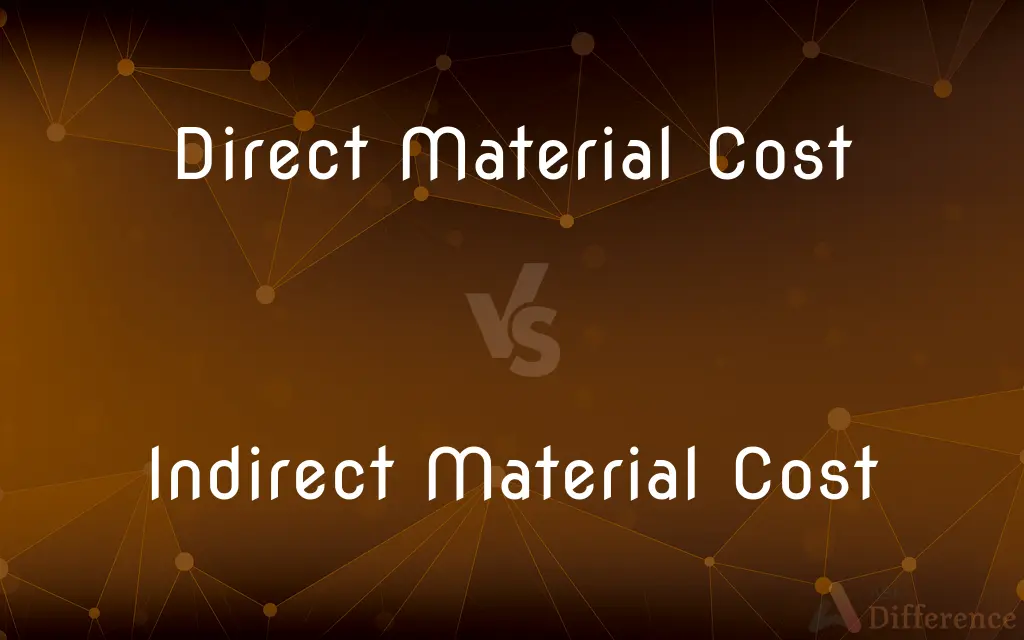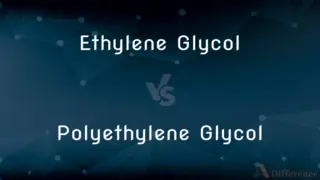Direct Material Cost vs. Indirect Material Cost — What's the Difference?
By Tayyaba Rehman — Published on January 18, 2024
Direct Material Cost is the cost of raw materials that become part of the finished product, while Indirect Material Cost covers materials used in the production process but not part of the final product.

Difference Between Direct Material Cost and Indirect Material Cost
Table of Contents
ADVERTISEMENT
Key Differences
Direct Material Cost refers to the expenses incurred for materials that are a significant and integral part of the finished product. For instance, the cost of wood used in furniture making. In contrast, Indirect Material Cost includes expenses for materials that, while essential for the production process, do not form a part of the final product, such as lubricants and cleaning supplies in a manufacturing plant.
Direct Material Costs are typically easy to trace and assign to a specific product, making them a key factor in product costing and pricing strategies. Indirect Material Costs, however, are more generalized and are usually allocated to products through a predetermined overhead rate since they support the production process as a whole.
In accounting, Direct Material Costs are directly tied to the production volume and have a direct impact on the cost of goods sold (COGS). On the other hand, Indirect Material Costs are often considered part of manufacturing overhead and are not directly linked to the production volume of any specific product.
Businesses closely monitor Direct Material Costs as they directly affect the profitability of each product. Conversely, Indirect Material Costs, while important for overall budgeting and cost control, do not directly influence the profitability of individual products.
In summary, Direct Material Costs are crucial for determining the cost and price of specific products, whereas Indirect Material Costs, though essential for the production environment, are part of the broader category of manufacturing overhead.
ADVERTISEMENT
Comparison Chart
Part of Product
Integral to the finished product
Not part of the finished product
Cost Tracing
Easily traceable to specific products
Allocated to products as overhead
Example
Wood for furniture, steel for machinery
Lubricants, cleaning supplies
Impact on COGS
Directly affects the cost of goods sold
Included in manufacturing overhead
Pricing Influence
Directly impacts product pricing
Indirect influence through overhead costs
Compare with Definitions
Direct Material Cost
A key factor in determining the cost of goods sold.
Direct material cost forms a large part of the COGS for electronics.
Indirect Material Cost
Classified as part of the manufacturing overhead.
Indirect material cost contributes to the overall overhead rate.
Direct Material Cost
Varies with the volume of production.
As production increases, the direct material cost per unit decreases.
Indirect Material Cost
The cost of materials used in production but not part of the final product.
Cleaning supplies are an indirect material cost in manufacturing.
Direct Material Cost
A significant component of the total manufacturing cost.
Reducing the direct material cost can significantly lower the product price.
Indirect Material Cost
Difficult to trace to a specific product.
The cost of glue and nails is an indirect material cost in furniture making.
Direct Material Cost
The cost of raw materials that become a part of the finished product.
The direct material cost for the car includes steel and rubber.
Indirect Material Cost
Allocated to products through overhead rates.
Indirect material costs are distributed across products based on predetermined rates.
Direct Material Cost
Traced directly to the production of specific goods.
The direct material cost for each table includes wood and varnish.
Indirect Material Cost
Supports the production environment but not specific goods.
Factory maintenance supplies fall under indirect material cost.
Common Curiosities
Are indirect material costs included in product pricing?
Indirectly, as they are part of the manufacturing overhead that affects pricing.
Can reducing direct material costs impact profitability?
Yes, lower direct material costs can increase the profitability of a product.
What is included in direct material cost?
Direct material cost includes all raw materials that are part of the final product.
Do direct material costs fluctuate with production volume?
Yes, they usually increase or decrease with changes in production volume.
Is it easier to trace direct or indirect material costs?
Direct material costs are easier to trace to specific products.
Can indirect material costs be controlled?
Yes, through efficient resource management and overhead control.
How are direct material costs calculated?
By multiplying the quantity of materials used by their cost per unit.
Are direct material costs variable costs?
Yes, they are variable as they vary with production levels.
Can indirect material cost vary?
Yes, it can vary based on changes in production practices and overhead allocation.
Can indirect material costs be reduced?
Yes, by improving operational efficiency and reducing waste.
What is a common method for allocating indirect material costs?
Using a predetermined overhead rate based on labor hours or machine hours.
How do businesses manage direct material costs?
By negotiating with suppliers and optimizing material usage.
Are packaging materials considered direct material costs?
Yes, if they are part of the final product's packaging.
Do indirect material costs affect the cost of goods sold?
Indirectly, as they are part of the overhead costs.
Is labor cost a direct material cost?
No, labor cost is typically classified as a direct labor cost, not a material cost.
Share Your Discovery

Previous Comparison
a-Law vs. u-Law
Next Comparison
Affiliate Marketing vs. Digital MarketingAuthor Spotlight
Written by
Tayyaba RehmanTayyaba Rehman is a distinguished writer, currently serving as a primary contributor to askdifference.com. As a researcher in semantics and etymology, Tayyaba's passion for the complexity of languages and their distinctions has found a perfect home on the platform. Tayyaba delves into the intricacies of language, distinguishing between commonly confused words and phrases, thereby providing clarity for readers worldwide.
















































